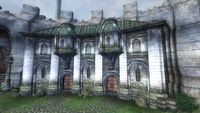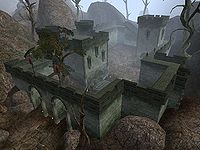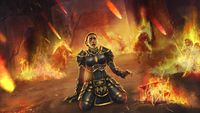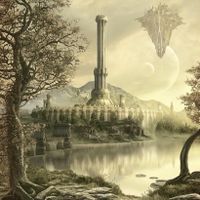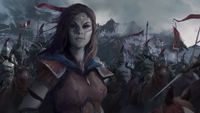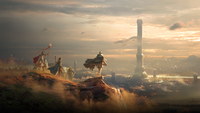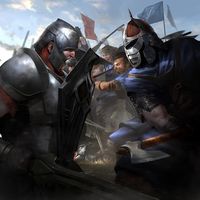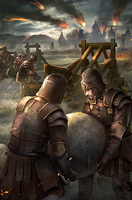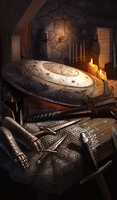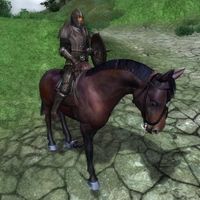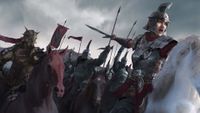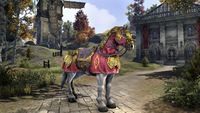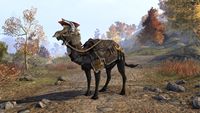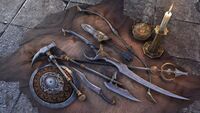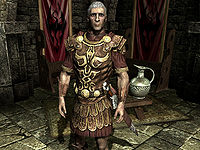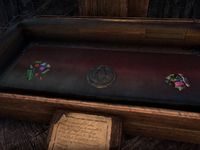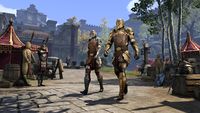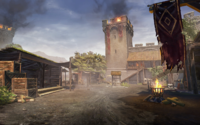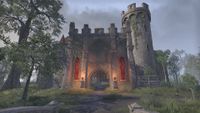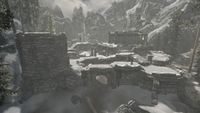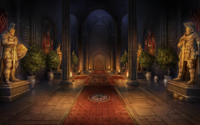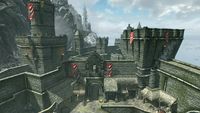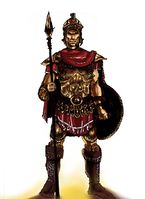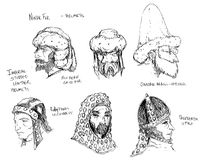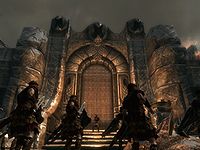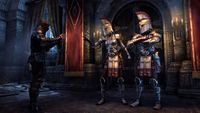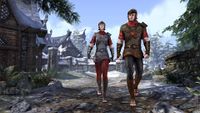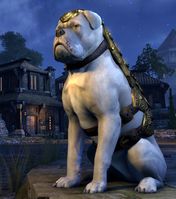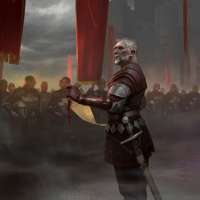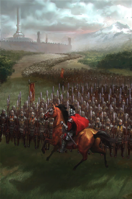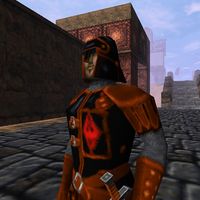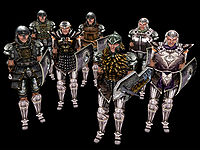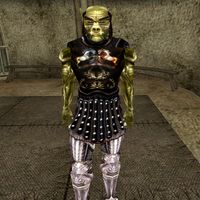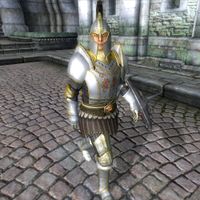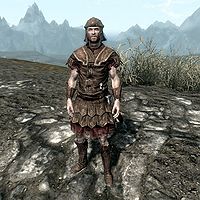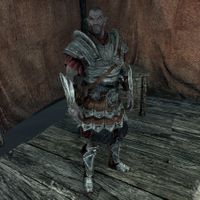Lore:Imperial Legion
Contents
- "Upon my honor I do swear undying loyalty to the Emperor… and unwavering obedience to the officers of his great Empire. May those above judge me, and those below take me, if I fail in my duty. Long live the Emperor! Long live the Empire!" —Imperial Legion oath
The Imperial Legion, also known as the Imperial Army,[1] Dragon-Tribe of the Emperor,[2] the Red Legions,[3] and the Ruby Ranks,[4] is the main fighting force of the Empire of Tamriel. It is often pluralized as the Imperial Legions. Headquartered in the Imperial City Prison,[5] they operate under the auspices and authority of the Emperor himself. With its vast numbers, quality training, and rigid discipline, the Legion is considered one of the best armies ever assembled in history. The primary mission of the Imperial Legion is to preserve the peace and rule of law in the Empire.[6] Those who protect the Emperor and the Imperial Province are sometimes called the Imperial Guard and the Imperial Watch.[7][8] A Legion Centurion is typically in command of the Palace Guard of the White Gold Tower.[9] The Legion's administration is known as the Imperial War Office.[10]:Part 3, Chapter 4
In peacetime, the Legion serves primarily as a garrison force — manning forts, patrolling roads, and providing guardsmen for towns, cities, counties, and nobles.[11][12] They are empowered to arrest criminals and seize their property, among other things.[13] In wartime, the Legion's responsibilities and powers are greatly increased. During conflicts, the Legion serves as an invading and occupying force, overwhelming opposition with numerical superiority and strict economy of force. The aquatic equivalent of the Imperial Legion is the Imperial Navy, with the two often overlapping.
Overview[edit]
The Legion is divided into structured and disciplined military units; the primary, and largest, of which is the Legion, which is further divided into Cohorts.[14] Legions are numbered for identification, and each possesses a proud history and sub-culture.[15] The Imperial Battlemages are a rich tradition of war mages trained in the support of the Legions. All facets of warfare are accounted for in Legionary operations, and the Legion employs large numbers of highly-specialized troops in conjunction with one another to achieve victory, among them archers, light and heavy cavalry, battlemages, and healers.[15][16] Imperial Battlemages are often mixed with other legions, but also form cohorts under a Battlemage Palatine, who acts as the commander of the cohort.[17] Imperial organizations, such as the Imperial Society, requisition legionnaire support as needed for their endeavors.[18] A special Legion platoon comprises the guard of any Duke in the province of Morrowind, the Duke of Vvardenfell, for instance. These soldiers are among the best the Legion has to offer; the most accomplished soldiers of the Duke's guard have the honor of serving as personal Palace guard to the King of Morrowind.[19] The Legion was also known to have an expeditionary force, that was known to have put down tribal uprisings in Black Marsh.[20]
The Legion's versatility is tied to its non-discriminatory recruitment. The Legion recruits individuals of all races and creeds into its ranks and benefits from the diversity of skills and backgrounds they bring (though Colovians form the majority). The Legion's strict standards for recruitment prioritise endurance, soldierly virtue, and trustworthiness, among other qualities. Kothringi were known to be a large part of the Imperial garrison of Gideon.[21] In the Second Era, Lyris Titanborn, a half-giant, was a member of the Imperial Legion and despite experiencing discrimination from some soldiers she rose quickly through the ranks due to her strength and height, eventually serving Emperor Varen Aquilarios personally.[22] The Legion is also one of the few groups to treat the Orcs well[23][24], with them forming a large number of soldiers in the Legion due to their natural strength and aptitude for smithing.[25] Disaffected Altmer also joined the Legion to resist the Thalmor in the Fourth Era.[26] Dunmer such as General Symmachus, who was one of Tiber Septim's closest subbordinates, also have played a major role in the Imperial Legion[27], the assassin Dram is another example of a high ranking Dunmer in the Legion.[28] Nords form a large part of the Legion too, with the Skyrim Legions being mostly made up of Nords, with the Nords benefiting from the Empire's protection and prosperous trade. In exchange, the people of Cyrodiil sleep peacefully, knowing their northern border is guarded by some of the fiercest warriors in Tamriel.[29] The Legion has also counted Dragons, such as Dragonne Papré and Nahfahlaar, within its ranks, the latter of these being employed to devastating effects in wars and the former being stationed in the Imperial Battlespire.[30]
Service in the Legion is considered a model of Imperial citizenship, and as such requires a high standard of excellence. Influential Imperial military families would often send their children to be trained in legionary academies, such as the Topal Legionary Academy, where they would be trained to be elite soldiers.[31] Legionaries are typically expected to be at the peak of physical fitness in order to weather the rigors of melee combat and long marches in heavy equipment, demonstrate mastery of blades, polearms, and blunt weaponry, and have great skill in utilizing heavy armor as well as hand-shields.[6]
Legions are known to have their own marching songs,[32] and also have skalds (war bards) that train in the Bards College.[33] Stendarr is the Patron of the Imperial Legion.[34][35]
History[edit]
The Alessian Legions[edit]
The first incarnation of the Imperial Legion arose under the Alessian Empire in the First Era, when it was known as the Alessian Legion.[36][37] Legends speak of the legions led by Morihaus when the man-bull took the White Gold Tower.[38] The Legion sprang from the hardy rugged stock of Colovia and the sophisticated battlemages of Nibenay. United, the warriors of Cyrodiil were a force to be reckoned with.
The Alessian army spent most of the third century of the First Era securing Alessian control over Cyrodiil, slowly overcoming Ayleid holdouts despite their magical prowess and often ingenious tactics.[39] The Alessians fought many Wars throughout the First Era; many cultures have legends speaking of the seemingly unstoppable legions of Empress Hestra circa 1E 1030.[40][41] Nevertheless, the Legion's fortunes have always waxed and waned along with the Empire. When the leadership of the Alessian Order succumbed to internal squabbling, the War of Righteousness began,[4] a decade-long civil war which no doubt pitted legionnaire against legionnaire.
Reman Era Legions[edit]
Once the province was reunited again under the god-hero Reman I circa 1E 2703, his legions spent the last two centuries of the First Era reestablishing an Empire of Man in Tamriel.[42][43] The Imperial Legion as it is known in modern times first appeared under the Second Empire, thanks to the influence of the Akaviri Dragonguard. Their weaponry, methods, and rigid discipline turned the Imperial Legion into the unparalleled fighting force which was able to conquer every region of mainland Tamriel (save for Morrowind). By the end of the era, the Summerset Isle was the only modern-day province which had no Legion presence.[4] A known member of a Reman era Legion was Luciana Pullo, a battlemage and lieutenant during the Akaviri troubles and Valenwood annexation.[44]
In 1E 2707, construction of Fort Redmane began under General Nemenius Hestor (commander of the Tenth Legion). General Hestor's original plans called for a powerful keep to be called Fort Niben, but construction proceeded fitfully. In the early years of Emperor Reman's reign, Cyrodiil's resources were sorely strained by the need to subdue threats all across Tamriel and so Khajiit brigandage in Blackwood simply did not rise to the same level as other threats. Frustrated by the parsimony of his superiors, General Hestor schemed to bring the threat posed by Anequinan raiders to their attention. He settled upon a fierce but formerly obscure Khajiit clan-chief named Hunzur-ri, and built him up as the leader of a wild horde of "beast-men" slavering for human blood. The general went so far as to name Hunzur-ri "the Red Mane," and describe him as a fanatical religious leader who had declared a holy crusade to drive men out of the Trans-Niben region altogether. General Hestor's plan worked and exaggerating the threat of the Red Mane caused gold to flood in to build the keep Hestor demanded to secure the border. In the meantime, Hunzur-ri found himself harassed by his fellow hunt-barons for "provoking" the Imperials. Infuriated by the fabrications flowing from General Hestor's reports, Hunzur-ri gathered a small band of loyal followers and crossed the Niben to seek out his foe—a dozen warriors in a single stealthy raid, not the rampaging horde he was said to command. Not an hour's march from the fort, Hunzur-ri and his warriors ambushed General Hestor. The general was killed by the very Khajiit he had vilified, but Hunzur-ri in turn was cut down by Hestor's soldiers. The Imperial Legion chose to describe Nemenius Hestor's death as a heroic last stand, in which the general bravely gave his own life to end the threat of "the Red Mane." A few years later, Fort Niben was renamed Fort Redmane in honor of the Legion's fierce adversary. Ironically, by the time the fort was completed, the troublesome raids that had impelled General Hestor to fortify the area in the first place had come to an end as the Khajiit kingdoms of Anequina and Pellitine were already under Imperial control.[45]
Blackwater War[edit]
The Blackwater War occurred between 1E 2811 - 1E 2837. A military expansion ordered by Reman II, which seized the northern and eastern marshes of Argonia, resulting in the formation of the Imperial Province of Black Marsh. While the Imperial forces won several decisive battles in the early stages, their progress quickly stagnated due to the brutal terrain, endless raids, disease, and mysterious disappearances. After several failed campaigns, each employing wildly differing tactics, the conflict declined into a protracted and complex guerrilla war with no clear victor in sight. Ultimately, tribal infighting on the part of the Argonians finally brought the war to a close. Rather than an official armistice, the war simply ended when the Argonians abruptly buried their weapons and went back to their day-to-day lives.[46][47]
- Battle of Argonia, 1E 2811. A one-sided affair with Argonians suffering significant casualties. The survivors retreated to Helstrom, the impenetrable center of the Province.
- Xi-tsei Massacre, Last Seed 14, 1E 2820. The remnants of General Bucco's fourth legion were annihilated by a massive Argonian war party at the foot of an ancient Argonian pyramid.
- Great Burn, Rain's Hand, 1E 2828. In an attempt to neutralize the inhospitable terrain, Elissia Mallicius ordered a unit of sappers to set fire to a peat bog outside of Stormhold. Unbeknownst to the Legion, the fire spread through a vast underground network and within months the entire province was ablaze. Hundreds of species of unique flora and fauna were rendered extinct and entire tribes of Argonians were lost. The Legion suffered significant casualties, this marked the end of their second campaign.
Four-Score War[edit]
The Four-Score War took place between 1E 2840 - 1E 2920 and was centered around the border regions of Morrowind, with the armies of the Reman Dynasty facing the Tribunal-led forces of the Dunmer. The war was initiated by Reman II after he had successfully taken over Black Marsh. Reman II died fighting the Dunmer in 1E 2843 and the war was continued by his successors Brazollus Dor and Reman III.
The war ended when Akaviri Potentate Versidue-Shaie signed the Cervant Truce with Vivec. As a result, Morrowind remained the only Tamrielic nation independent of the Second Empire until its collapse in 2E 430.
- Battle of Bodrum, 20th of First Seed, 1E 2920. Forces led by Vivec ambushed the Cyrodilic army and almost completely destroyed it.
- Battle of Ald Marak, 16th of Mid Year, 1E 2920. A heavily armored army led by Imperial Crown Prince Juilek took the Dunmer by surprise due to faulty intelligence on their part. Commanding the mystics in the Legion to cast water-breathing spells, his army passed through Lake Coronati, with the majority of the Dunmer army commanded by Vivec being unable to respond to the attack in time.
- Battle of Black Gate, Sun's Height, 1E 2920. While a truce between the warring parties had been called, the Legion sacked the fortress of Black Gate.
Under the Akaviri Potentates at the beginning of the Second Era, the Imperial Legion achieved something unthinkable: they became the only fighting force in the Empire. In 2E 283, when faced with widespread rebellion, Potentate Versidue-Shaie declared martial law, demanding that all of his vassals dissolve their armies. After thirty-seven years and enormous sacrifice, the Imperial Legion had quelled all who did not obey, wiping out any organized resistance to them within the Empire. They were the only army in the land.[48]
Puppets of Pretenders[edit]
During the Interregnum of the Second Era, after the dissolution of the Second Empire, the Imperial Legion became the instrument of various warlords in Cyrodiil, notably the infamous Tharn family. Many disparaged the Legion around Tamriel during this time, claiming that it no longer exemplified the superb qualities it had in the past.[49] At the beginning of the Planemeld, all Legions were recalled to the Imperial City,[50] but many couldn't make it to City Isle and instead set up isolated camps throughout the Heartlands as the Alliance War raged around them.[51] Legionaries who were in the Imperial City when the Anchors began to drop were given the option to swear fealty to Molag Bal by drinking the "Blood of Coldharbour", a poison that would slowly turn the imbibers into Mind-Shriven.[52] Many instead chose death, but those who turned traitor formed a new regiment called Legion Zero.[53] Legion Zero cooperated with the Xivkyn occupiers, and transformed the Elven Gardens District into a workshop for constructing siege equipment for the Daedric forces.[54]
A group of loyalist legion soldiers led by Captain Anatolius Caudex, known as the Immortal Eight, created an improvised garrison in the middle of the Nobles District in the Imperial City, where they fought against the forces of Molag Bal and against Legion Zero.[55] They also played a part in stopping Bal's plans to snuff out the Dragonfires.[56] Captain Caudex had previously defended Fort Warden from the three Alliances, being the last man to leave the fort, stating that the "Rebels must learn that the Empire is invincible. So we must be invincible."[57]
Elsewhere in Tamriel, Legion troops under the command of the Tharns became engaged in relatively minor campaigns to annex surrounding regions, with little long-term success. Circa 2E 582, Colovian troops under Javad Tharn entered Aldmeri Dominion territory in a failed attempt to annex the Reaper's March region south of Colovia.[51] Under Magus-General Septima Tharn, the Seventh Legion became engaged in operations across much of Tamriel, often with very little support.[58] An example of this was when the Seventh Legion entered Daggerfall Covenant territory in a failed attempt to annex Bangkorai.[51] The Legion's leadership was encouraged to act ruthlessly, and they often engaged in abductions, as well as summary executions of disloyal soldiers, disobedient prisoners, or recalcitrant conquered civilians.[59]
In Anequina, during the Frostfall Coup of 2E 576, the Cygnus Irregulars feigned loyalty to Euraxia Tharn due to being outnumbered by her Nibenese mercenaries.[60] However, they often sabotaged her plans as well as being outspoken on the invasion of Rimmen. Later in 2E 581, Prefect Calo anticipated that the Irregulars would eventually work alongside Lord Gharesh-ri against the Euraxians and so had been training them in preparation for joining their forces.[61] In 2E 582, the Cygnus Irregulars were pardoned by Lord Gharesh-ri and formed an alliance with Queen Khamira against Euraxia Tharn. Following this, the Irregulars helped at the Dov-Vahl Shrine, standing guard against any Euraxian reinforcements while the Dragonhorn was recovered. The Irregulars assisted the Northern Elsweyr Defense Force at the Moon Gate of Anequina, holding off the Euraxians and dragons from Jode's Core.[62] After the defeat of the Euraxians and dragons in Northern Elsweyr, the surviving Irregulars and Prefect Calo attended the royal coronation of Queen Khamira. She accepted the assistance of the Cygnus Irregulars to help Elsweyr as engineers and aide workers.[60]
A group of all-female legionaries known as the Diamond's Daughters intended to take part in the Dragonstar Arena in order to bring Imperial law and order back to Craglorn.[63][64]
In the region of Blackwood in Cyrodiil, hundreds of former Imperial legionaries stationed in Blackwood had received neither pay nor orders from Cyrodiil in months, with their units having been effectively disbanded. These legionaries were recruited by the Council of Legates in Leyawiin to become part of the Ivory Brigade by offering to make good on their back pay and confirming their role as protectors of the province. These legionaries acted as the core of the Ivory Brigade, with native Blackwooders forming a militia around them, these Blackwooders provided knowledge of the terrain, people, and conditions of Blackwood, while the veteran legionaries taught the militia military discipline and Imperial fighting skills.[65]
The Tiber War[edit]
In 2E 852, the Tiber War began, and nothing would ever be the same. In the dead of winter, General Talos led a small army from Cyrodiil to take the mighty fortress of Sancre Tor from the allied Nord-Breton forces which had occupied it. The Cyrodilic army was small, poorly trained and outfitted, short on rations and unprepared for winter campaigning. And yet, the man who would become known as Tiber Septim led them to victory.[66]
The Battle of Sancre Tor was just the beginning of a renaissance for the Imperial Legion. With his invincible General Talos, King Cuhlecain was able to unite the Colovian Estates in a year, and soon thereafter in 2E 854 took the Imperial City, taking the title of Emperor. He was soon killed, and Emperor Tiber Septim took his place. His ever-loyal soldiers solidified his hold on Cyrodiil and began invasions on Skyrim and High Rock,[67] after which young men in Skyrim began to flock to Septim's armies.[68] With Septim's rule in High Rock, Skyrim, and Cyrodiil solidified, Septim attacked Elsweyr.[69]
The Legion suffered its share of tribulations while forging the Empire of Tamriel. In the Battle of Black Rocks in 2E 863, the Aldmeri Dominion almost destroyed the Third Legion[69] and the initially smooth annexation of Hammerfell the following year was disrupted by the Stros M'Kai Uprising.[67] For a brief time during the Moth Rebellion, Tiber Septim was driven out of the Imperial City and the Legion within the city was besieged.[69] And Tiber's generals positively dreaded a campaign against the Dunmer of Morrowind (though they were spared from attempting to conquer the entire province thanks to the Armistice).[70]
One by one, the provinces were brought into the fold. The Summerset Isle had never been successfully invaded by the Legion, though they were reportedly more than capable of repulsing elven incursions.[71] But finally, in 2E 896, Septim's use of the Numidium brought the homeland of the Altmer under his control, making him the first true Emperor of Tamriel.[67]
The Third Empire[edit]
Under the Septim Empire, the Imperial Legion regained its reputation as a model military force.[72] From Morrowind to the Summerset Isles, the Legion helped keep the peace. It had to manage a great deal of insurrection, the many major wars of the Third Era,[73] and piracy,[74] not to mention the disastrous invasion of Akavir circa 3E 288.[15] They developed and maintained a system of garrisons throughout Tamriel, manning and supplying each in accordance with the threats they faced (though some questioned the significance of these threats given the exorbitant cost of maintaining this system).[75] During this time, they were known for their close association with the Imperial Cult, which frequently provided services in their forts.[76] The Legion maintained a strong presence in Morrowind throughout the Third Era, and it is believed that Dagoth Ur, before his defeat at the hands of the Nerevarine, was preparing for an extended campaign against them utilizing assassination and terror.[77]
At some point in the Third Era, the Imperial Watch came into possession of a section of pillar carved by the Ayleids and infused with significant destructive power. The Imperials attempted to harness some degree of this magical power by bringing the stone to the summit of Cloud Top in the Colovian Highlands. Wizards from the Mages Guild were brought in to tune the stone to react to shock magic, and the Imperials achieved some measure of success at harnessing this power. The site was ultimately abandoned due to the danger posed by the stone's reaction.[78][79]
3E 427[edit]
The Imperial Legion had a great presence in Vvardenfell under the Septim Empire, with there being many forts dotted around the island; Fort Darius, Buckmoth Legion Fort, Moonmoth Legion Fort, and Fort Pelagiad were main strategic locations. Pelagiad itself was founded by Legion veterans that had retired.[80]
In Gnisis, the Deathshead Legion helped secure the Gnisis Kwama egg mine, as the queen had been blighted. Eventually, the legion cured the queen of the Blight, allowing work to continue in the local area.[81] Certain members of the Deathshead Legion were involved in a conspiracy involving the Talos Cult, planning to assassinate Uriel Septim VII and replace him with a stronger ruler. This conspiracy was put down by General Darius.[82]
The Hawkmoth Legion was mostly involved in matters involving the Ordinators and Buoyant Armigers - the legion being accused of having no courtesy by the Armigers[83], and an Ordinator spreading lies about the legion.[84] The legion resolved the strained relationship with the Armigers by beating one of their members in a contest of wit, poetry, and honor. The Ordinator that had been spreading lies was slain by the legion.[85] The Ordinators also attempted to kill an Imperial Knight that had been accused of murder. This attempt on his life was stopped by the legion so that he could get a fair trial on the mainland instead.[86]
The Buckmoth Legion prevented illegal trading of Dwemer artifacts due to all Dwemer artifacts being considered as the Emperor's property.[87] It also saved a knight of the Order of Ebonheart and assisted the Armigers in preventing a scandal involving an affair.[88]
The Moonmoth Legion assisted the Nerevarine by giving them supplies due to the influence of the Grand Spymaster of the Blades, Caius Cosades.[89] Larrius Varro, a Legion Champion, was also present at Moonmoth. He tasked a legionnaire to kill a Nord who had been robbing travelers near Hla Oad.[90] Varro also tasked the Nerevarine with killing five members of the Camonna Tong in Balmora, as the local magistrate was corrupt and was taking gold from the Camonna Tong to reduce criminals sentences and fines. After they were killed, Varro rewarded the Nerevarine with the Ring of Surroundings and informed the Emperor of their deeds.[91] The Moonmoth Legion rescued a Breton priest who had been kidnapped by the Erabenimsun Ashlanders.[92] They also rescued an Imperial citizen from raiders near Gnaar Mok[93]. Gnaar Mok also had a problem with a pair of breeding Netch that had become aggressive and were a threat to the village, which the Legion solved by killing them both. Furthermore, the Legion also dealt with a necromancer known as Sorkvild the Raven, in an effort to prove to the Dunmer that the Legion would root out necromancers no matter where they hide.[94]
3E 433[edit]
During the Oblivion Crisis, the Legion mainly found itself engaged in a stalling action against the incredible onslaught of Mehrunes Dagon. Leyawiin's Count in Cyrodiil complained that High Chancellor Ocato was inordinately concerned with other provinces even as Oblivion Gates opened throughout the Imperial Province itself.[95] The denizens of Morrowind's Great House Redoran claimed that the Legions were recalled to Cyrodiil instead.[96] Due to the Legion focusing on the other provinces, Martin Septim could not count on Legion support during the battle at the Great Gate at Bruma.[97]
A company of Legion soldiers were traveling to the Imperial City during the Crisis in order to protect it from the Daedra, however, an Oblivion Gate opened in the middle of them, killing half of them. The Imperial Captain, Tertius Ione managed to save the rest and temporarily retreated, he then mustered together local farmers and hunters from the surrounding areas and from Pell's Gate. Ione returned with his remaining legionaries and freshly recruited auxiliary forces and slaughtered the Daedra, he then entered the Gate with about 52 men, while the other half guarded the gate. Due to Ione's sacrifice, a Bosmer named Fenton was successful in closing the Gate. The remaining Legion soldiers settled the area and named the settlement Ione in the Legion Captain's honor.[98]
On the island of Solstheim, a group of Nords attempted to destroy Fort Frostmoth and claim the island for themselves, the Legion held them off from the Fort and Raven Rock.[99]
After the Septims[edit]
Reachmen of Bthardamz[edit]
At an unknown point during the early 4th Era, an Imperial Spymaster known as Porcia Loran was in command of an Imperial Legion phalanx that were preparing to wipe out the Reachmen Doomfang clan at Bthardamz. However, her former subordinate Talym Rend was forced by Sheogorath to ensure Porcia would lose her sanity.[100] Talym intercepted a Reachman letter detailing plans to use Dwemer Animunculi to deliver a deadly poison to the Legion's forces. Talym refused to show Porcia, instead planting false letter for her to discover. She was later captured by the Reachmen while seeking this false intelligence and was rescued by Talym. Porcia was led to believe that an antidote for the poison could be made using sacred flowers from a Grove of Mara by Talym's deceit. The priestesses of Mara refused to let Porcia have the flowers which drove her to personally assault the Grove and take them to save her men.[101]
The Legion's alchemists refined these flowers into a gas that was meant to negate the effects of the poison. They were to deploy the antidote after the Reachmen had released the poison so as to make the best use of their limited supply. However, the gas actually caused large explosions when it reacted with the poison, resulting in the death of most of the Reachmen and the legionaries. The outcome of her mission, while technically a victory, led her to retire from the Legion due to the fear of uttering a command that could potentially hurt others.[102]
Umbriel Crisis[edit]
Following the Oblivion Crisis, the Imperial Legion steadily grew weaker. During the Umbriel Crisis, an undead army advanced on the Imperial City in an effort to take control of the White-Gold Tower, causing mass panic among its citizens. The Imperial Legion attempted to hold the line along the Red Ring Road, but were ultimately driven back to the walls of the city. The Synod and the College of Whispers worked together with the Legion to bring down the floating city, but also failed. In the end, Umbriel was banished by a group of heroes, but by that time the Legion already suffered heavy losses.[98][10]
Night of Green Fire[edit]

In 4E 42, Altmer dissidents who had fled to Sentinel from the Thalmor in Summerset Isle were attacked by Thalmor operatives. Their efforts to fight back against the Thalmor were in vain, and by the time Imperial Legion soldiers arrived, the entire refugee district of the city had been destroyed. The Dominion, not content with killing dissidents at home, came to Hammerfell to finish the job. An Altmer Legate known as Fasendil was one of the soldiers stationed there.[26]
The Great War[edit]
The Thalmor rose to power again in the Summerset Isle, and the Legion could not stop them from reforming the Aldmeri Dominion. The Thalmor eventually delivered an ultimatum to Emperor Titus Mede II demanding a series of enormous concessions. When the Emperor refused, the Great War began.[103] The Aldmeri Dominion initially invaded deep into the heart of Cyrodiil, capturing Leyawiin and Cheydinhal rapidly before the Legion could mobilize an effective defense. More Dominion armies invaded into Hammerfell, bypassing western Cyrodiil entirely. When they realized the weakness of the Legion, however, the Aldmeri Dominion grew bolder and mobilized an offensive against Cyrodiil as a whole, intending to bring the entire Empire under their control. Quickly, Bruma and the Imperial City were the only cities that remained under Legion control in Cyrodiil. Meanwhile, the legions in Hammerfell were pressed hard and forced to retreat, leaving the entire southern half of Hammerfell to fall to the Dominion. The Imperial City itself came under siege. Though relieved by several legions of hardened Nord legionaries, the Emperor ultimately gave the order to break the siege and abandon the city. An entire Legion sacrificed itself to defend the Emperor's rear.[103]
At this time, the Imperial Palace was sacked, plundered, and burned with the Aldmeri Dominion seeking an Imperial surrender. While the Emperor strung them along, he recalled all the legions defending Hammerfell and rearmed and refreshed the Skyrim and Cyrodilic legions. However, General Decianus allowed a great number of "invalids" to be discharged from the Legions before they marched east in an effort to drive the Altmeri back from Skaven. These veterans formed the core of the army that eventually drove the Altmeri General Arannelya's forces back across the Alik'r late in 174, with the Dominion forces taking heavy losses on their retreat from harassing attacks by the Alik'r warriors.[103] This successfully duped the Thalmor into believing the entire army was still fighting them there.
Martius Silius was a commander in the Imperial Legion during the war, however he and his men got separated from their legion. They ended up deep in Aldmeri-controlled territory and decided to make as much trouble there as they could. During the winter they raided camps at night, and attacked caravans bringing supplies to the front. This went on for weeks, until they rejoined the Imperial forces just in time for the Battle of the Red Ring. They were just a dozen left at that point, but they fought valiantly and helped retake the Imperial City.[104] During the Battle of the Red Ring the Emperor stormed south with his refreshed legions as the Hammerfell legions came in from the west. The Aldmeri Dominion, caught by surprise, was attacked by the Hammerfell legions from the west, while the Skyrim legions swept east and south and the Emperor, along with his personal Cyrodilic legions, assaulted the Imperial City, surrounding it on three sides and fending off Dominions piecemeal reinforcements and blocking their retreat from the Imperial City. They retook the Imperial City and all of Cyrodiil.
In the end, the Legion was victorious, though exhausted, no Legion had more than half its forces fit for duty, and Two Legions of soldiers had been effectively annihilated, not including the loss of the Eighth Legion in the retreat from the Imperial City the previous year. But the Emperor believed that with this victory was the best time to negotiate peace with the Dominion and put an official end to the war, resulting in the White-Gold Concordat being signed, which essentially gave in to all the Thalmor's initial demands.[103] Hammerfell, however, was unwilling to concede defeat and the loss of so much of their territory, and so, in order to preserve the peace with the Dominion, the Emperor officially renounced Hammerfell as part of the Empire.[103][98]
Skyrim's Civil War[edit]
In Skyrim circa 4E 201, with the ascension of Ulfric Stormcloak to the Jarlship of Eastmarch and the death of High King Torygg at Ulfric's hands, civil war broke out.
The Imperial Legion moved in to secure Imperial territory as the jarls began picking sides. The Legion went through several commanders until under General Tullius was brought in who managed to stabilize things on the Imperial side, instilling much faith among both his soldiers and Imperial citizenry. On the 15th of Last Seed,[nb 1] less than a year after the start of the conflict,[nb 2][nb 3] Ulfric and his men were ambushed by the Legion outside Darkwater Crossing in southern Eastmarch. Among those captured was a horse-thief from Rorikstead, and the Last Dragonborn who was apprehended attempting to cross the border at Pale Pass from Cyrodiil. After surrendering, they traveled for two days until they arrived in Helgen for execution.[105]
Before the execution could fully take place, Helgen was attacked by the dragon Alduin, and Ulfric escaped, signalling the return of dragons to Skyrim. This event took all sides unawares: the Empire, Stormcloaks, and Thalmor observers. The ongoing civil war meant many cities and settlements were unable to commit resources to defending from the dragons.[106] Afterwards, the war escalated, with Nords across Skyrim solidifying their allegiance to either the Empire or the Stormcloaks.[107]
Armor, Arms and Transport[edit]
—Verita Numida
Legionaries are specially outfitted depending on a large number of factors, including climate, location, task, and expectations. They employed armors of chain, scale, plate mail, and gender-neutral skirts in the province of Morrowind in 3E 427, heavy steel plate overlying chain mail in the capital province of Cyrodiil during the Oblivion Crisis, and lighter leather, chainmail, and steel plate armors in Skyrim during the Stormcloak Rebellion. Battlemages tend to wear hoods, healers wear light padded armor, guardsmen on loan to nobles wear the vestments of their town, city, county, or hold, and rangers and foresters tend to wear fur or leather apparel in addition to their Legionary armor. Dragonscale armor and shields are also used, with the craft coming from Akavir and being implemented since the Reman Empire.[4] In addition, the uniform may vary depending on the culture of the local area or province.
Legion foot soldiers mainly use Imperial swords, steel swords, and Imperial bows.[108] However, other weapons are often used as well, such as broadswords, shortswords, spears, pikes, claymores, axes, daggers, warhammers, maces, and staffs.[109][110][111] The Legion mass-produces crossbows that are used by its missile troopers alongside short and long bows.[112]
The Imperial Legion also employs siege machines such as catapults, battering rams, trebuchets, and ballistae.[113][114][54]
The Daggerfall Covenant based their armor designs on Reman Era Legion armor, with their chest pieces as an example.[115] The Order of the Hour also based their armor design on that of the Second Era legions.[116]
The Imperial Legion also utilizes different types of cavalry, with the main type being horses. Many breeds of horses are used by the Imperial Legion, such as the Bay horse.[117]. However, other animals have been mounted by Legion cavalrymen throughout history as well. The bear cavalry first came into use by 10th Legion in 2E 23.[118] Camels have been ridden in Hammerfell, guar in Morrowind,[119] sabre cats in Skyrim,[120] and wolves in High Rock.[121] When Empress Hestra led her Legions in harrying the Vampire King Styriche and his Gray Host into western Hammerfell, it's said she did so while riding a great flame atronach bear.[122] In the event of a crisis behind enemy lines, a legionnaire may sell excess material to non-combatants. Such material must have no significant military application. Gold acquired in this manner must be used to secure passage back to the legion.[123]
Gallery of Arms[edit]
Known Legions[edit]
- Legion Zero — A traitorous Imperial Legion that had sworn fealty to Molag Bal during his invasion of the Imperial City, becoming Mind-Shriven.[124]
- Second Legion — Led by General Nipia, the Second Legion accompanied Varen Aquilarios during the Colovian Revolt, and were headquartered in the vicinity of Bruma during peacetime. After Leovic was disposed of in 2E 577, the Second Legion pursued the Icereach Coven of Reachmen, who had worked alongside Leovic, into Falkreath where many legionaries fled due to the effects of Mother Ciannait's magic. The Optio in charge of this particular regiment was prepared to continue the chase if the High Command of the Second Legion wished for it, but advised the Legate to allow legionaries to return to Cyrodiil. [125] The Imperial War Mastiff is their mascot and symbol.[126]
- Third Legion — Also known as the Faithful Third. Helped to put down the Moth Rebellion in the Imperial City in 2E 857 alongside Tiber Septim's honor guard. In 2E 863 the forces of the Aldmeri Dominion caught the Third Legion by surprise and almost destroyed it. The remnants of it made the core of the newly created Ruby Legion stationed in the Nibenay Valley. The Sack of Senchal was carried out by the Third Legion. Attrebus was a known member.[69]
- Fourth Legion — Led by General Augurius Bucco in 1E 2811 and participated in the Blackwater War. The Fourth Legion was completely decimated on the 14th of Last Seed, 1E 2820. Reformed under General Regulus Sardecus circa 1E 2823, the Fourth Legion regained all territory that had been lost in Black Marsh.[127] A deserter from this legion worked against the forces of Molag Bal during his invasion of the Imperial City, actively destroying the enemy's siege weapons.[128]
- Fifth Legion — Led by Captain Lampronius circa 2E 582, who trained recruits. The Fifth Legion was recreated in 3E 288 and participated in the Invasion of Akavir as one of the initial landing legions. Fifth Legion Porter, an alcoholic beverage, is named after them.[15]
- Sixth Legion — Little is known of the Sixth Legion, with only one known member, Antonia Gratas, who was stranded in Craglorn and so followed Legion protocol by selling any surplus equipment to secure passage back to her Legion.[123]
- Seventh Legion — Had taken control of Southern Bangkorai during the Three Banners War in 2E 582. Later participated in the Invasion of Akavir in 3E 288 as one of the initial landing legions.[15] In the 4th Era the Seventh Legion, along with the Fifteenth Legion defended Orsinium.[10]
- Eighth Legion — Fought a desperate and doomed rearguard action on the walls of the Imperial City in 4E 174, while Titus II broke out of the city to the north with his main army.[103]
- Ninth Legion — Part of the first group of Imperial troops sent to Black Marsh, the legion was lost in Tsofeer Cavern in Murkmire.[129] The Ninth Legion was recreated sometime before 3E 288 and participated in the Invasion of Akavir as reinforcements.[15]
- Tenth Legion – Riders of the first Imperial bear cavalry in 2E 23, who would parade their bear mounts Leyawiin's streets each week.[118][130] Participated in the Invasion of Akavir in 3E 288 as one of the initial landing legions. Only two members survived and told of how the Tenth Legion's final stand allowed remnants of the Fourteenth Legion to reach Septimia and reported on the death of Uriel V.[15] The Tenth Legion was recreated sometime before the Great War with Legate Justianus Quintius as their commanding officer, they participated in both Hammerfell and Cyrodiil.[103]
- Twelfth Legion – The Twelfth Legion were involved in the defense of the Imperial City during the Umbriel Crisis and worked alongside the Imperial Cavalry. [131]
- Thirteenth Legion – Led by General Renmus, Emperor Aquilarios sent the Thirteenth Legion to Senchal in 2E 578 to help restore order after the Knahaten Flu had ravaged the area. The legion defended the Khajiit as they rebuilt and formed a city council alongside the Khajiit. The legion came to be known as the 'Shields of Senchal'.[132]
- Fourteenth Legion – Participated in the Invasion of Akavir in 3E 288 as one of the initial landing legions.[15]
- Fifteenth Legion – A Legion involved with defending Orsinium during the Fourth Era.[10]
- Seventeenth Legion – Participated in the Invasion of Akavir in 3E 288 as a reinforcement legion.[15]
- Eighteenth Legion – Captain Evernal was a known member of the Eighteenth Legion, with him having a badge displaying this fact.[98] Evernal was later a part of a group of Imperial Regulators outside of the city of Rimmen, where they searched visitors for contraband such as Moon Sugar.
- Imperial Guard – Referred to as a 'shadow legion', the Imperial Guard served as the personal protectors of the Emperor. General Warhaft was a known member.
- Imperial Battlemages - Well-trained war mages serving in the Imperial Legion.
- Cygnus Irregulars – A division of the Imperial Legion that mostly consists of military engineers, scouts, and trainers.
- Legion of Chorrol – The Legion based in Chorrol during 2E 576, participated in Varen's Rebellion and helped to overthrow Emperor Leovic.[133]
- Legion of the West Weald – An Imperial Legion from Colovia led by General Lavinia circa 2E 582. The Legion had annexed Arenthia and had planned to take over the Northern Woods.[134] This Legion includes remnants of the Third Cohort that remained stationed in Skingrad following the Soulburst.[135]
- Deathshead Legion – An Imperial Legion based in Gnisis in 3E 427 led by General Darius. It consisted primarily of Orcs.[136]
- Hawkmoth Legion – An Imperial Legion based in Castle Ebonheart in 3E 427 led by Knight Protector Frald the White.[137]
- Moonmoth Legion - An Imperial Legion based in Fort Moonmoth in Balmora, led by Radd Hard-Heart. [138]
- Diamond Marines – A division that participated in the Blackwater War.[46]
- Longhouse Legions – The name given to the legions that remained loyal to the Longhouse Emperor Leovic that fought against forces of Varen Aquilarios during Varen's Rebellion.[139]
Imperial Legion Ranks[edit]
General Officers[edit]
- Grand Marshal[141][142]
- Admiral/General, commanders of one or multiple legions.[12][107][143] It is noted that at least one of them attends each meeting with the Elder Council, in order to forward any Elder Council decisions to the other generals and the Legionary's Council, where all military matters are discussed.[144] Generals may choose to defy the Emperor's/Empress' direct orders.[145][146] Magical projections are used to quickly pass orders around if no battlemages are available to do so.
- Aide–de–Camp, acts as a secretary to an Imperial general, in charge of recruiting and spreading information and orders.[134]
- Commander[147][148]
- Legate, general officers often associated with politics. Legates were below the rank of general, and would often command legions.[149][150]
- Knight of the Imperial Dragon[151]
Senior Officers[edit]
- Tribune, serve in each legion below the rank of legate.[152][153]
- Prefect/Praefect, serve in legions below the rank of tribune. Prefect Calo led his own cohort known as the Cygnus Irregulars.[60] Ephrem Benirus was a known governing prefect of Anvil.[154]
Junior Officers[edit]
- Centurion, Centurions have their own field armor and dress armor.[155] Centurions are also a part of the palace guard in the Imperial City.[156][157][158]
- Optio[159][125], Optios report to Legates and the High Command of a legion.
- Champion[151]
- Commandant[160]
- Chapter Steward, known to deal with recruitment
- Captain, Captains are known to write monthly reports to their higher ups such as centurions.[16] They are also sometimes known as a Captain of the Guard.[161][162][50]
- Agent[151]
- Lieutenant, serve as masters–at–arms in the legion, keeping soldiers always ready for battle.[163] They reported to captains.[164]
Non–Commissioned Officers[edit]
Lower Ranks[edit]
- Soldier/Legionary/Legionnaire, the common foot soldier of the Imperial Legion, the most common rank by far.
- Private[167]
- Trooper[151]
- Spearman[151]
- Recruit[151]
- Auxiliary, non-citizen soldiers and provincials. They provided additional manpower when needed.[168]
- Quaestor[168]
- Legion Paymaster, a member of the legion who pays severance to families of who have lost loved ones while in service of the Imperial Legion, this severance is paid monthly.[169]
- Surgeon, doctors who served in the Imperial Legion.[170][171]
- Prison Guards, Prison Guards can be ordered and pulled to serve as additional reinforcements for the Imperial Legions.[172]
Imperial Legion Knight Ranks[edit]
Artifacts[edit]
There are a few artifacts that are commonly associated with the Legion:
- Akatosh's Talon[173]
- The Boots of the Apostle, which belonged to Tiber Septim[174]
- The Dragon's Oath[173]
- The Lord's Mail which is considered sacred to the Legion and is accepted as Legion uniform[175][176]
- The Ward of Akavir[177]
Known Legion Forts[edit]
| This page or section is incomplete. You can help by adding to it. For more information, see the help files, the style guide, and this article's talk page. |
- Arrius Keep — A keep in northeastern Cyrodiil, northeast of the Imperial City. Played a strategic role in the Alliance War.
- Arx Corinium — An Imperial fort found in northwestern Black Marsh.[178]
- Ashfallow Citadel — An Imperial fort in southeast Solstheim.
- Bleaker's Outpost
- Blue Road Keep — A keep in central Cyrodiil, found on the Blue Road.
- Borderwatch — Formerly a Legion keep, taken over by the Ivory Brigade in the Second Era. No longer a fort by the end of the Third Era.
- Carmala Outlook — A small fort between Chorrol and Skingrad in Cyrodiil.
- Castle Bloodmayne — A keep in southern Cyrodiil. Played a strategic role in the Alliance War, where it was occupied by the Aldmeri Dominion.
- Castle Brindle — A keep in western Cyrodiil. Brindle acts as a protector for the nearby town of Vlastarus.
- Castle Dour — An ancient castle in the city of Solitude. Castle Dour acted as the headquarters of the Imperial Legion in Skyrim in 4E 201.
- Crooked Finger Redoubt – A small fort in Mist Morrow Vale in eastern Cyrodiil.
- Drakelowe Keep — A keep in eastern Cyrodiil. Drakelowe acts as a protector for the nearby town of Cropsford.
- Eagle's Strand — An Imperial fort located on the southern half of Khenarthi's Roost.[179]
- Empire Tower — A tower located southwest of Fort Aleswell in central Cyrodiil. During the Three Banners War, the Goblin Rock Bone Tribe camped here.
- Feldagard Keep - A keep that is responsible for Skingrad's defenses in the Colovian Hills.[180]
- Fort Alessia
- Fort Aleswell — A keep in central Cyrodiil along the Red Ring Road. The town of Aleswell is southeast of the fort.
- Fort Ash — A keep in central Cyrodiil.
- Fort Black Boot — A small fort between Bravil and Skingrad. During the Oblivion Crisis, the fort was occupied by hostile conjurers.
- Fort Blueblood
- Fort Buckmoth — A fort south of Ald'ruhn, home to the Buckmoth Legion.
- Fort Caractacus — A fort north of the Imperial City.
- Fort Chalman
- Fort Darius — A fort built into the hillside of Gnisis, home of the Deathshead Legion
- Fort Doublecross
- Fort Dragonclaw — A keep in northern Cyrodiil. During the Three Banners War, the Daggerfall Covenant controlled it.
- Fort Dunstad
- Fort Faleria — A legendary fort built under the Alessian Empire. Tribune's Folly, an Imperial ruin east of Anvil is suspected of being this fort.[181]
- Fort Farragut
- Fort Fellhammer
- Fort Firemoth
- Fort Frostmoth
- Fort Grief
- Fort Kastav
- Fort Neugrad
- Fort Redmane
- Fort Sphinxmoth
- Fort Sungard
- Fort Swampmoth — A keep in Black Marsh.[99]
- Fort Warden
- Ilinalta's Deep — A sunken Imperial fort found at Lake Ilinalta.
- Rootwatch Tower — A watchtower found northeast of Woodhearth in Valenwood.
- Snowpoint Beacon — A watchtower found east of Fort Fellhammer in Winterhold
- Western Watchtower
Gallery[edit]
Appearances[edit]
Notes[edit]
- The Imperial Legion was inspired by the Roman Legions who were the supreme military power in Europe during classical antiquity.
- A 33rd cohort is mentioned in ESO, while Roman Legions were known to only have 10 in a single Legion. If there were 33 cohorts, the number of men would equal ~16,000 in a single Legion, instead of the standard ~5000 men in the Roman Empire.[14]
- Battlemages of the "33rd" supposedly helped to banish Mehrunes Dagon at some point in Kvatch.[UOL 1] However, it is unclear if this refers to a Thirty-third Legion, a Thirty-third Cohort that is part of any Legion, or something else entirely.
- The Tribunal God Vivec referred to the Legion as "moths".[182]
- Officers of the Imperial Legion and knights of the various Imperial military orders were privileged to wear Templar Heavy Armor.[183][184][UOL 2]
- The Red Templars (also known as the Red Dome Templars) were unstable crusaders who drank the blood of Talos in order to obtain short-term martial shouting powers. They were hated by the rest of the Legion and a significant number of the members of the Elder Council wanted them dispersed. Due to this, they were mainly sent off to remote places like Morrowind.[185][UOL 3]
See Also[edit]
- For game-specific information, see the Morrowind, Oblivion, Skyrim, and Elder Scrolls Online articles.
Books[edit]
- A Legionary's History of Fort Redmane Written by Pristan Vinicio, Centurion, 19 Sun's Dawn, 2E 233 — A history of an unused fort
- Arms and Armor of the Imperial Champion, Hall Steward Longinus Attius
- Arx Corinium — First Seed Report by Centurion Pontius — An Imperial officer's journal outlining the difficulties in the construction of Arx Corinium
- Before the Gates of Gideon by Wud-Selas — Historical fiction about an Argonian attack on Gideon during the Blackwater War
- Call to the Faithful by Prudentia Blaesus — A call to religious followers
- Centurion's Signet — A quote from the first Orcish Centurion in the Imperial Legion
- Ice and Chitin by Pletius Spatec — A tale of the manipulation of chitin armor
- Manual of Armor — Guide to the various types of armor available for Imperial use
- Manual of Arms — Guides to the various types of weaponry available for Imperial use
- On Morrowind by Erramanwe of Sunhold — A historical synopsis of the Imperial conquest of Morrowind
- On the Ivory Brigade by Tarnian Lovidicus, Chief Councilor and Member of the Chamber of Legates — A history of the Ivory Brigade
- Ordo Legionis — An introduction to the Imperial Legion
- Report: Disaster at Ionith by Lord Pottreid, Chairman — An Imperial-scripted dispatch concerning Uriel V's invasion of Akavir
- The Armorer's Challenge by Mymophonus — A competition between two skilled armorsmiths
- The Blackwater War by Valenca Arvina, Historian-in-Residence at Gwylim University — A historical account of Black Marsh's annexation as an Imperial Province
- The Eastern Provinces — On the benefits and liabilities of the ongoing management of Morrowind and Black Marsh
- The Fall and Rise of Reman's Bluff by Praetor Aemilianus Lector — Details of an Imperial fort besieged by Orcs in the late First Era
- The Great War by Legate Justianus Quintius — A soldier's summation of the major events before and during the Great War
- The Holds of Skyrim — The official guide of the Imperial Legion to Skyrim and its holds
- The Siege of Ald Marak by Siege-Master Germia Demetrius — A recounting of how the Imperial Legion overthrew an imposing Dunmer fortress
- Thibaut's Cairn and its History by Charonius of Sutch — On the hero Thibault and his resting place
- Topal Legionary Academy: A Khajiit's Summary by Zargit the Studious — A Khajiit's view of the Topal Legionary Academy
- Words and Philosophy — An interview with a Bosmer master swordsman about her life
Articles[edit]
- Tiber Septim — The conqueror of Tamriel
- Blades — The elite Imperial order who often assisted the Legion
- General Warhaft — The general of the Imperial Guard under Emperor Uriel Septim VII
- Penitus Oculatus — The Emperor's spies that replaced the Blades after the Oblivion Crisis
- Imperial Battlemages — Imperial Legion battlemages
- Imperial Cult — An article on the Imperial faith and the missionary arm of the Empire
- Imperial Navy — The naval fighting force of the Empire
- Red Templars - A Talos-worshipping branch of Legion known for its disobedience
- East Empire Company — An Imperial trading company protected by the Legion
- Sirollus Saccus – A master blacksmith for the Imperial Legion
References[edit]
- ^ The Wolf Queen — Waughin Jarth
- ^ Dreekius' dialogue in Redguard
- ^ Heimskr's dialogue in Skyrim
- ^ a b c d Pocket Guide to the Empire, 1st Edition: Cyrodiil — Imperial Geographical Society, 2E 864
- ^ Imperial City Prison loading screen text in ESO: Imperial City
- ^ a b Ordo Legionis
- ^ Assassination!
- ^ Gray Fox, Man or Myth? — Black Horse Courier
- ^ Palace Break-In?
- ^ a b c d Lord of Souls — Greg Keyes
- ^ Events of Oblivion
- ^ a b Events of Morrowind
- ^ Public Notice — Adamus Phillida
- ^ a b An Ancient Love Letter — Rogano
- ^ a b c d e f g h i Report: Disaster at Ionith — Lord Pottreid, Chairman
- ^ a b Report: Quality of Recruits — Captain Lampronius
- ^ Battlemage Palatine armor description in ESO
- ^ Ruins of Kemel-Ze — Rolard Nordssen
- ^ Duke Vedam Dren's guards in Morrowind
- ^ Peace in Black Marsh dialogue option in Morrowind
- ^ 2920, Morning Star — Carlovac Townway
- ^ Meet the Character - Lyris Titanborn — Irnskar, Prince of Windhelm
- ^ Moth gro-Bagol's dialogue in Skyrim
- ^ Centurion's Signet
- ^ Orc racial description in Oblivion
- ^ a b Legate Fasendil's dialogue in Skyrim
- ^ Biography of Queen Barenziah — Stern Gamboge, Imperial Scribe
- ^ Dram Character Biography - Redguard.com
- ^ Balgruuf the Greater's dialogue in Skyrim
- ^ There Be Dragons — Torhal Bjorik
- ^ Topal Legionary Academy — Zargit the Studious
- ^ Legionnaire Marching Song
- ^ Jorn's dialogue in Skyrim
- ^ Stendarr dialogue topic of the Imperial Cult in Morrowind
- ^ The Elder Scrolls V: Skyrim: Prima Official Game Guide — David Hodgson
- ^ Picnic at Pelin (A Horror Story) — DeWitte Bourbois
- ^ The Royal House of King Eamond — Seneschal Derric Andras of Castle Evermore
- ^ Cherim's Heart of Anequina — Livillus Perus, Professor at the Imperial University
- ^ Daughter of the Niben — Sathyr Longleat
- ^ The Legend of Red Eagle — Tredayn Dren
- ^ Lost Legends — Talsgar the Elder, Archivist of Winterhold
- ^ Pocket Guide to the Empire, 3rd Edition: Other Lands — Imperial Geographical Society, 3E 432
- ^ 2920, The Last Year of the First Era — Carlovac Townway
- ^ Meet the Character - Proctor Luciana — Grimrald Brassbones
- ^ A Legionary's History of Fort Redmane — Pristan Vinicio, Centurion, 19 Sun's Dawn, 2E 233
- ^ a b The Blackwater War — Valenca Arvina, Historian-in-Residence at Gwylim University
- ^ Pocket Guide to the Empire, 3rd Edition: The War with the Trees: Argonia and the Black Marsh — Imperial Geographical Society, 3E 432
- ^ History of the Fighters Guild
- ^ Bangkorai, Shield of High Rock — King Eamond
- ^ a b Imperial Recall Orders — Captain Virgilus
- ^ a b c Events of ESO
- ^ Captain Regilus' dialogue
- ^ The Drake of Blades Answers Your Questions — The Drake of Blades
- ^ a b Dousing the Fires of Industry quest in ESO
- ^ The Imperial Standard quest in ESO
- ^ The Sublime Brazier quest in ESO
- ^ Meet the Character - Captain Caudex — Lieutenant Gavo Haderus
- ^ Imperial Infiltration quest in ESO
- ^ Septima Tharn's Leadership Maxims — Magus-General Septima Tharn
- ^ a b c Prefect Calo's dialogue in ESO: Elsweyr
- ^ Captain Saulinia's Instructions
- ^ Jode's Core quest in ESO
- ^ Cinia Vinipter's dialogue in ESO
- ^ Lucina Fortis' dialogue in ESO
- ^ On the Ivory Brigade — Tarnian Lovidicus, Chief Councilor and Member of the Chamber of Legates
- ^ Battle of Sancre Tor
- ^ a b c The Arcturian Heresy — The Underking, Ysmir Kingmaker
- ^ Pocket Guide to the Empire, 1st Edition: Skyrim — Imperial Geographical Society, 2E 864
- ^ a b c d Attrebus' biography on Redguard's old site
- ^ On Morrowind — Erramanwe of Sunhold
- ^ Pocket Guide to the Empire, 1st Edition: Aldmeri Dominion — Imperial Geographical Society, 2E 864
- ^ Mixed Unit Tactics — Codus Callonus
- ^ Brief History of the Empire — Stronach k'Thojj III
- ^ Cap'n Dugal's Journal — Torradan ap Dugal
- ^ The Eastern Provinces
- ^ For my Gods and Emperor — Imperial Cult
- ^ Dagoth Ur's Plans — Tribunal Temple
- ^ Earana's Notes — Earana
- ^ Fingers of the Mountain quest in Oblivion
- ^ Pelagiad dialogue option in Morrowind
- ^ Gnisis Eggmine quest in Morrowind
- ^ Talos Cult Conspiracy quest in Morrowind
- ^ Courtesy quest in Morrowind
- ^ Suryn Athones' dialogue in Morrowind
- ^ Suryn Athones' Slanders quest in Morrowind
- ^ Saprius Entius quest in Morrowind
- ^ Dwemer Artifacts at Drinar Varyon's Place quest in Morrowind
- ^ Maiden's Token quest in Morrowind
- ^ Meet Sul-Matuul quest in Morrowind
- ^ Fjol the Outlaw quest in Morrowind
- ^ Larrius Varro Tells a Little Story quest in Morrowind
- ^ Rescue Jocien Ancois quest in Morrowind
- ^ Rescue Dandsa quest in Morrowind
- ^ Sorkvild the Raven quest in Morrowind
- ^ Count Marius Caro's dialogue in Oblivion
- ^ Adril Arano's dialogue in Skyrim: Dragonborn
- ^ Allies for Bruma quest in Oblivion
- ^ a b c d The Infernal City — Greg Keyes
- ^ a b Rumors in Oblivion
- ^ Isle of Madness Episode 4 intro dialogue
- ^ Grove of Mara dialogue in Isle of Madness
- ^ The Betrayal dialogue in Isle of Madness
- ^ a b c d e f g The Great War — Legate Justianus Quintius
- ^ Arielle Themond's dialogue in Blades
- ^ Ralof's dialogue in Skyrim
- ^ Jouane Manette's dialogue in Skyrim
- ^ a b Events of Skyrim
- ^ Imperial Soldier's weapons in Skyrim
- ^ Imperial weapons in Morrowind
- ^ Imperial style weapons in ESO
- ^ Champion's Cudgel in Skyrim: Dragonborn
- ^ Garothmuk gro-Muzgub's dialogue in Morrowind
- ^ Siege Catapult card art in Legends
- ^ Imperial Camps in Skyrim
- ^ Crafting Motif 26: Daggerfall Covenant Style — General Baryctor Stelanie
- ^ Crafting Motif 40: Order Hour Style — Amminus Entius, First Quartermaster of the Order
- ^ Imperial Legion use of Bay horse in Oblivion
- ^ a b Akaviri Potentate Bear mount description in ESO
- ^ Akaviri Potentate Guar description in ESO
- ^ Akaviri Potentate Sabre Cat description in ESO
- ^ Akaviri Potentate Wolf description in ESO
- ^ Flame Atronach Bear mount description in ESO
- ^ a b Antonia Gratas' dialogue in ESO
- ^ Captain Regilus' dialogue in ESO
- ^ a b Meet the Character - Mother Ciannait
- ^ The Wolf and the Dragon — Midara Salviticus, Historian, University of Gwylim
- ^ The Blackwater War — Valenca Arvina, Historian-in-Residence at Gwylim University
- ^ Quintia Rullus' appearance in ESO
- ^ Legion Officer's Notebook
- ^ Akaviri Potentate Bear Cub pet description in ESO
- ^ Lord of Souls — Greg Keyes Page 339
- ^ The Shields of Senchal — Ziri, Chronicler of the Senchal City Council
- ^ Eulogy for Emperor Varen — Lord Abnur Tharn, Chancellor of the Elder Council
- ^ a b Yours for the Taking! — Catonius Libo, Aide-de-Camp to General Lavinia Axius
- ^ Commandant Salerius in ESO
- ^ Darius' dialogue in Morrowind
- ^ Hawkmoth Legion in Morrowind
- ^ Moonmoth Legion in Morrowind
- ^ Longhouse Legion Banner Fragment item description in ESO
- ^ Scavenger Legion Helm hat description in ESO
- ^ Letter to the Grand Marshall of the Imperial Legion — Clarentavious Valisious
- ^ The Blackwater War, Volume 1 — Valenca Arvina, Historian-in-Residence at Gwylim University
- ^ The Great War
- ^ Minutes of the Elder Council
- ^ General Velarius' dialogue in ESO
- ^ General Raetus' dialogue
- ^ Giovanni Civello in Oblivion
- ^ Adamus Phillida in Oblivion
- ^ Legate Rikke in Skyrim
- ^ Moth Sister Terran Arminus Answers Your Questions — Moth Sister Terran Arminus
- ^ a b c d e f g h i j Imperial Legion ranks in Morrowind
- ^ Battlemage Tribune armor description in ESO
- ^ Arx Corinium — First Seed Report — Centurion Pontius
- ^ Letter of Fiscal Absolution
- ^ Centurion outfits in ESO
- ^ Imperial Guard Centurion Uniform in ESO
- ^ Centurion Gavo in ESO
- ^ Centurion Solinthia in ESO
- ^ Optio Bologra in Morrowind
- ^ Commandant Weston in ESO
- ^ Captain Ululmalit in ESO
- ^ Captain Gemelle in ESO
- ^ Sylvian Herius' dialogue in ESO
- ^ To Delay Means Death — Captain Virgilus
- ^ Establish Watchposts — Captain Priscus
- ^ Imperial Sergeant apperence in ESO
- ^ Captain Aldis' dialogue in Skyrim
- ^ a b Imperial Legion Ranks in Skyrim
- ^ Elianna Pevengius dialogue in ESO
- ^ Surgeon Andronicus in ESO
- ^ Silver-Plated Tweezers
- ^ Evacuation Order — Porcius Sisenna
- ^ a b Civil War Champions creation in Skyrim
- ^ Torasa Aram's dialogue in Morrowind: Tribunal
- ^ Lord's Mail quest in Morrowind
- ^ Letter to General Tullius
- ^ Siege at Firemoth quest in Morrowind
- ^ Arx Corinium — First Seed Report — Centurion Pontius
- ^ Commander Karinith's dialogue in ESO
- ^ Report on Feldagard Keep
- ^ The Lost Fort Faleria
- ^ 36 Lessons of Vivec, Sermon 19 — Vivec
- ^ Elderscrolls.com Codex Archive
- ^ Imperial Templar Armor in Morrowind
- ^ People of Morrowind — Various
Note: The following references are considered to be unofficial sources. They are included to round off this article and may not be authoritative or conclusive.


